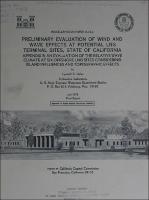Please use this identifier to cite or link to this item:
https://hdl.handle.net/11681/10608| Title: | Preliminary evaluation of wind and wave effects at potential LNG terminal sites, State of California : Appendix B: an evaluation of the relative wave climate at six offshore LNG sites considering island influences and topographic effects |
| Authors: | California Coastal Commission Hales, Lyndell Z. |
| Keywords: | California Water wave refraction Water waves Liquefied Natural Gas terminal sites LNG Wind Meteorology Topography Wind waves Water wave characteristics Hindcasting Hindcasts |
| Publisher: | Hydraulics Laboratory (U.S.) Engineer Research and Development Center (U.S.) |
| Series/Report no.: | Miscellaneous paper (U.S. Army Engineer Waterways Experiment Station) ; H-78-2 app.B. |
| Description: | Miscellaneous Paper Abstract: The State of California Liquefied Natural Gas (LNG) Terminal Act of 1977 granted to the Public Utilities Commission (PUC) the exclusive power to issue a permit concerning the construction and operation of an LNG terminal pursuant to a prescribed permit procedure. The Act also required the California Coastal Commission (CCC) to study potential sites for the terminal and to make recommendations thereon to PUC. The U. S. Army Engineer Waterways Experiment Station (WES) was requested to assist in the preliminary evaluation of the wave climate at alternate potential LNG terminal sites by applying existing hindcast wave data of a general nature to obtain estimates of the times of excessive wave conditions at the various sites. After the preliminary evaluation was completed, WES was again requested to assist by analyzing the effects of island sheltering and topographic influences on the wave climates of five onshore sites (Appendix A of H-78-2) and six offshore sites in order to provide a more refined estimate of the wave conditions existing at the potential sites. The deepwater hindcast wave data used in the evaluations were the State of California Department of Navigation and Ocean Development (DNOD) singular wave statistics, National Marine Consultants (NMC) and Marine Advisers (MA) deepwater hindcast data, and the Synoptic Shipboard Meteorological Observation (SSMO) data tapes. CCC completed and transmitted to PUC its final report evaluating and ranking the five onshore sites 31 May 1978. Because of the absence of a comprehensive deepwater wave hindcast data base of sufficient degree of confidence to permit estimates of the absolute magnitude of occurrences of waves of different periods and heights, the analysis conducted is a relative evaluation only and should not be interpreted as projections of actual downtime, but rather as a consistently uniform basis for comparison. WES and others are at the present time engaged in a comprehensive program to provide a spectral hindcast of the California Coastal region; however, these results will not be available for approximately two years and the LNG site selection process cannot await these findings. When the appropriate topographic coefficients had been applied to the deepwater hindcast wave data and the resulting wave climate at the potential offshore LNG site had been obtained, it was required that the effects of this resultant wave climate be determined on four possible terminal concepts at each of the six sites. These four concepts include: (A.) fixed terminal with one pier, (B.) fixed terminal with two piers, (C.) floating barge, and (D.) deepwater mooring tower. These results are included in this report. Beyond the scope of this investigation, the possibility exists that each of the four concepts mentioned above can be restructured to produce as many as twenty different hybrid concepts to be considered at each of the six offshore sites. NOTE: This file is very large. Allow your browser several minutes to download the file. |
| Rights: | Approved for public release; distribution is unlimited. |
| URI: | http://hdl.handle.net/11681/10608 |
| Appears in Collections: | Miscellaneous Paper |
Files in This Item:
| File | Description | Size | Format | |
|---|---|---|---|---|
| MP-H-78-2-Appendix-B.pdf | 49.93 MB | Adobe PDF |  View/Open |